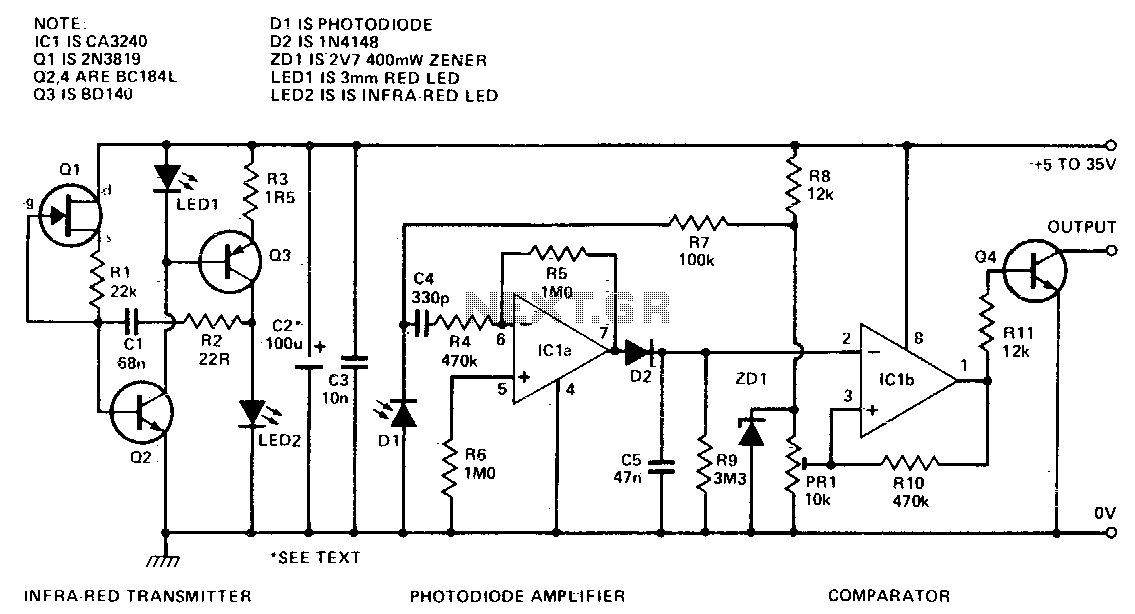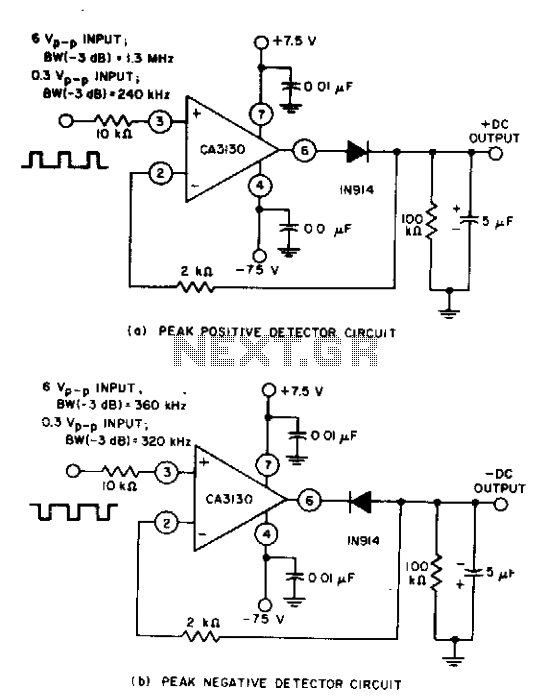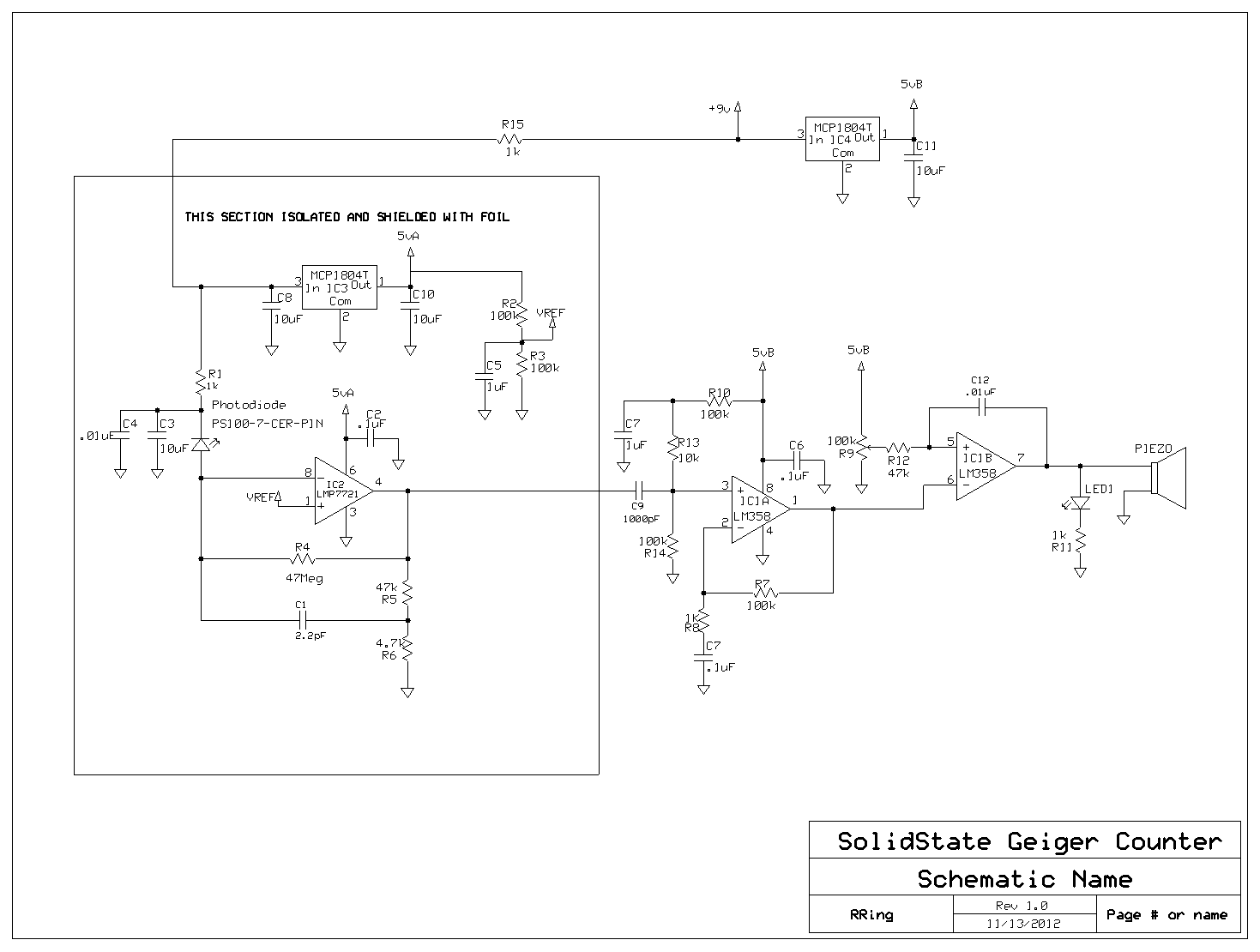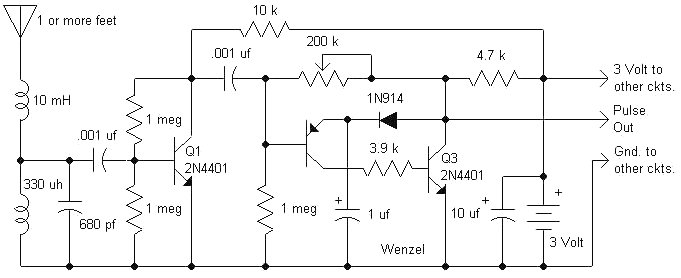
Proximity detector

This circuit detects the presence of objects through the reflection of infrared light, providing a direct digital output for object detection. By utilizing modulation and high-power bursts of infrared light at a very low duty cycle, it achieves a detection range exceeding one foot. It operates on the principle of transmitting a beam of modulated infrared light from the emitter diode (LED2) and receiving reflections from objects in front of the beam with a photodiode detector (D1). The circuit comprises an infrared transmitter, a photodiode amplifier, and a variable threshold comparator.
The circuit functions by emitting a modulated infrared light beam, which is generated by an LED (LED2). This LED operates at a specific wavelength, typically around 940 nm, which is invisible to the naked eye but detectable by the photodiode (D1). The modulation of the infrared light involves turning the LED on and off at a high frequency, which allows for distinguishing the emitted light from ambient infrared light sources, such as sunlight or artificial lighting.
When an object enters the detection area, it reflects the emitted infrared light back towards the photodiode. The photodiode converts the received light into an electrical signal. This signal is then amplified by a photodiode amplifier to ensure that the output is strong enough for further processing. The amplified signal is fed into a variable threshold comparator, which compares the received signal against a predefined threshold level. If the signal exceeds this threshold, it indicates the presence of an object, resulting in a digital output that can be used to trigger other devices or systems.
The variable threshold comparator is crucial for adjusting the sensitivity of the circuit, allowing it to be fine-tuned according to the specific application or environmental conditions. This adaptability makes the circuit suitable for various object detection tasks, from simple presence detection to more complex applications in automation and robotics.
Overall, this infrared object detection circuit is efficient, reliable, and capable of functioning effectively in diverse settings, making it a valuable component in many electronic systems.This circuit provides a means of detecting the presence of anything by the reflection of infra-red light and provides a direct digital output of object detection. By the use of modulation and high power bursts of infra-red at a very low duty cycle, a detection range of over a foot is achieved
Works on the principle of transmitting a beam of modulated infra-red light from the emitter diode LED2, and receiving reflections from objects passing in front of the beam with a photodiode detector Dl. The circuit consists of an infra-red transmitter, photodiode amplifier, and a variable threshold comparator.
The circuit functions by emitting a modulated infrared light beam, which is generated by an LED (LED2). This LED operates at a specific wavelength, typically around 940 nm, which is invisible to the naked eye but detectable by the photodiode (D1). The modulation of the infrared light involves turning the LED on and off at a high frequency, which allows for distinguishing the emitted light from ambient infrared light sources, such as sunlight or artificial lighting.
When an object enters the detection area, it reflects the emitted infrared light back towards the photodiode. The photodiode converts the received light into an electrical signal. This signal is then amplified by a photodiode amplifier to ensure that the output is strong enough for further processing. The amplified signal is fed into a variable threshold comparator, which compares the received signal against a predefined threshold level. If the signal exceeds this threshold, it indicates the presence of an object, resulting in a digital output that can be used to trigger other devices or systems.
The variable threshold comparator is crucial for adjusting the sensitivity of the circuit, allowing it to be fine-tuned according to the specific application or environmental conditions. This adaptability makes the circuit suitable for various object detection tasks, from simple presence detection to more complex applications in automation and robotics.
Overall, this infrared object detection circuit is efficient, reliable, and capable of functioning effectively in diverse settings, making it a valuable component in many electronic systems.This circuit provides a means of detecting the presence of anything by the reflection of infra-red light and provides a direct digital output of object detection. By the use of modulation and high power bursts of infra-red at a very low duty cycle, a detection range of over a foot is achieved
Works on the principle of transmitting a beam of modulated infra-red light from the emitter diode LED2, and receiving reflections from objects passing in front of the beam with a photodiode detector Dl. The circuit consists of an infra-red transmitter, photodiode amplifier, and a variable threshold comparator.





